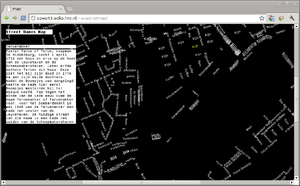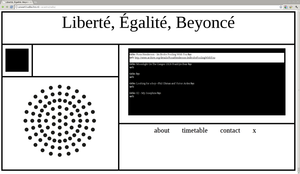User:Andre Castro/2.1/semniar-2012-10-10-summary
Project Proposal Draft
Short Description
For many of us our relation with spam emails consists in moving them from the inbox to the junk-mail directory of our email accounts, or even better, they are moved there by spam-filters sparing us from having to do it ourselves. However, if we take a look some of the unsolicited emails we receive we might find them curious, and might even amuse ourselves with what we find. My proposal goes towards considering spam a limit literary genre, and investigating its writing techniques as devices that can be used persuade receivers to engage in on-going exchange of text fragments. Despite being a simple exchange of emails, there would be an underlying narrative that unfolds as the exchange proceeds.
If we take a close look at some of the spam emails we keep on receiving we may consider there is something not too removed from a literary creation there. In my opinion there is a considerable amount of creativity, and awareness to the current global situation and society soft-spots, in spam emails. After all spam message must make use of these features, in order to make the message sound believable and persuasive enough for someone to be fooled into believing it. There are also the abundant language distortions that resulting from spam writing process, such as the heavy employment of stereotypes, the unconventional uses of the English language, Google-translate misinterpretations, typos, word obfuscation, recurrence of text fragments or characters under different contexts, which I find highly interesting. However, for various and legitimate reasons, we don't read the spam messages that arrive in our electronic mailboxes. Would we begin to read, and perhaps even respond to them, if their intention was not to try to extort money from us, but in producing fruition? Could spam promote fruition? Could it even ask for the receivers' active participation in that fruition?
I would like to give a positive answers to these questions. I will attempt to do so by appropriating spam writing and transmission methods, and re-purpose it, so that its central intention becomes not the extortion money, but of words. I will assume the role of a spammer, who sends bulk email to unrequested addresses. Those emails, although written by employing some of the techniques used by spammers, but contrarily to typical spammers, I will entice users to answer, so that together, through this exchange a collaborative text will be produced.
Method
The method I plan to employ in this work consists in devising a pre-written screenplay, where certain variables a left open.
This script will be given to a writing robot who, based on it, will have the task of producing responses to the receivers who responded to the first email. Based on each responder's answers, combined with the bot's own choices, the screenplay variables will be filled and the subsequent actions taken, based on those variables.
Method step-by-step
- A first email is sent to a bulk of email address, containing a dubious, but somehow enticing and poetic message
- Once a receiver responds, and consequently enters the game, s/he will be enticed to keep on answering, to keep on writing. The writing bot, making use of its capabilities, will write a reply that relates to receiver's answer, but also opens other narrative paths.
- Several emails will be exchanged using this device. The more the receiver writes, the more the bot will get to know him/her, but also more wild and hopefully intrigued its replies will be.
- All the written material produced both by receivers and bot is collected (to be put to later use).
- At a certain point, the receiver who is in the game will be disconnected from the bot and connected to another human receiver, who happens to also be in the same writing stage. The central node - the bot - will remove itself as the central node in the communication, to replace it a connection between the two receivers will be established.
General Methodology of Work
The methodology I have employed in the constructions of my works generally begins by encountering a problem or frustration. I come across something in which I see potential, but due to some blockage, it is under-explored. As an example, I found a great wealth of audio material available at Internet Archive, however its interface tended to conceal most of the material. This frustration led me to ask how could the diversity and quantity of material become more apparent and accessible.
A stage of experimentation and research generally follows. At this point I try to broaden my question, find possible angles to approach it, find other approaches to similar problems, engage with my subject and experiment. The Engage with the subject seems crucial. It is a step towards the object of research, trying no to look at it from a distance, but to get close to it, to establish a dialog. This happen more clearly in Data Factory when I tried to engage direct-marking companies' employees into talking with me and clarifying my questions a bout direct-marking and users' privacy.
Loose experimentation seems also important to my work methodology. From it a more precise idea about the materials I am engaging with is formed, and the final approach begins to surface.
The following stage is one of concretization of the elected approach, bringing it from its experimental stage, through various prototypes to its final from. It is at this point when most decisions are made, such as what to include or exclude, in what context should the project exist, how it will function, what will be its appearance. In the example I have been giving, I decided for an online radio, exclusively based on audio material from IA, that would group the sound materials under given programs with specific genres.
The resulting object is rarely, a solution for the problem which initiated the work process. Rather than providing an answer it will be an imaginative solution that ought pose more questions, and show the problem under another, perhaps unexpected, perspective. Hopefully such approach will challenge the value of the object in question, and allow it to reveal itself under another form.
Description of my works in the past year
To begin with I started by writing on the performativity of code. Departing from Katherine Hayle's notion of code performativity I went on looking at how does code perform. How does code, rather than being a descriptive tool, has the capacity to act, to change things in the real world, similarly to a performative speech-act, such as a judge stating: "I pronounce you guilty of the crime", and often with very direct and material effects.
Simultaneously I developed and online map of the streets of Rotterdam. This map - a striped-down version of the original map of Rotterdam - only displayed the city street names against a black background, on the browser. By clicking on each street a request was made to the City of Rotterdam's Archive to provide information on that particular street's name origin. That information was then displayed alongside the map.
What I seemed to be creating here was an interface to access city's archive through a different channel. By having the indexes of the archive - the street names - displayed on the screen I might see and ask for information on streets that I wouldn't be normally interested in. It opened up the possibility for a serendipitous navigation through the city name's history.
The same serendipitous exploration made its way to the next project, Radio Liberté Egalité Beyoncé (RLEB). RLEB was an online radio-station with a schedule composed of audio content fetched form Internet Archive. One-hour long cycles presented the listener with ten-minutes chunks of various sound materials, picked at chance the archive, from within a specific categories, such as french talk-shows, hiphop, poetry readings, ambient music, etc. The design of website where RLEG was hosted presented a drawing of radio, with which the listener had to interact in order to get the radio playing.
The essay written alongside the RLEB began by tracing the archive's historical ties to power, functioning as a legitimator of power and knowledge. It mentioned the ideology which underlies any archive, even folkloric archive such as Youtube, an which can be best perceived through what is kept from entering the archive. Never-the-less important differences exist between a physical offline archive and a digital online one: the latter has the potential of a wider access, and also to let its item be taken by visitors, without risk of impoverishing it. These differences result in an invitation for appropriation and transformation of the digital archive. When one of its items is taken and transformed, a new version of it appears, and a certain confusion emerges over its origin - which one is the original and which is fictitious? When remixed versions surface, they change the archive into a space of dialogue and emergence of discourses, rather than a site aimed at legitimizing power and knowledge.
Data Factory looked at direct marking companies' acquisition of consumers data, with the aim to target individual consumers with products which they might be more inclined to buy. It consisted of a small archive of recordings from phone-calls made to such companies. During the calls I tried to sell them their business main ingredient - consumer data - with the catch being the fact that "consumer" here meant only myself. Through the reactions to this simple short-circuit the ideology behind such business model became more apparent. The calls were gathered together in a website, with a certain corporate style, in which they could be listened to, in parallel to images illustrating or ridiculing what was being said.
The essay The Work of Audiences departed from Dallas Smythe's work On the Audience Commodity and its Work. In Smythe's view, the audience job consists in creating demand for advertised goods. What advertisers buy when placing an advert on a magazine, TV-show of website is the audiences' attention and their capacity to buy what is being advertised. It happens that the labor of this immaterial work-force changed under the Web 2.0, as noted by Andrejevic. Audiences are no longer simply asked to generate demand for advertised goods, but also to put their creativity to work in producing many of the contents that surround those adverts, and also make the Web. By doing so audiences also develop a community around their creations, and produce information about their behavior, which will be used in targeting advertisement directed at them. In exchange audiences receive a small amount of control over their creations, which are ultimately property of the company hosting them. Following this line of thought I asked whether there was a difference from the work of audiences on platform like Youtube to one like Wikipedia. The situation seems to be that although Wikipedia also lives on audiences' free creative labor, they are given more control over their creations, and engage in discussions over the functioning of Wikipedia. Is this difference enough for the work of audiences to be classified as less exploitative than on Youtube?



